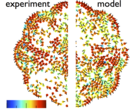Long-range Ordering of Vibrated Disks
C. A. Weber, T. Hanke, J. Deseigne, S. Léonard, O. Dauchot, E. Frey, and H. Chaté
The emergence of collective motion in fish schools and bird flocks constitutes a ubiquitous and fascinating phenomenon in nature. One reason might be the emergence of highly dynamic, coherently moving spatial patterns such as clusters, swirls or waves, and the fact that the patterns commonly extend over length scales much larger than the size of the individuals.
In our letter we consider a reconstituted system of vibrated granular particles in order to understand the underlying principles of swarm formation. As in case of birds and fish, these granular particles gives rise to fascinating self-organized swarms due to strongly dissipative particle interactions (see Figure). We constructed a theoretical model that quantitatively matches the properties of the single particle, binary collision and collective dynamics in the “flower-like” geometry (see Figure). Since fully ordered asymptotic regimes could not be reached in the confined experimental system our model allowed to show that true long-range order is possible in the experimental system.


